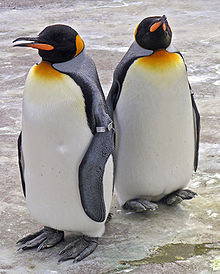 Global Information
Global InformationFlightless bird information

Penguins are a well-known example of flightless birds.


Ostriches are the largest extant flightless birds as well as the largest extant birds in general.

Flightless birds are birds that, through evolution, lost the ability to fly.[1] There are over 60 extant species,[2] including the well-known ratites (ostriches, emus, cassowaries, rheas, and kiwis) and penguins. The smallest flightless bird is the Inaccessible Island rail (length 12.5 cm, weight 34.7 g). The largest (both heaviest and tallest) flightless bird, which is also the largest living bird in general, is the common ostrich (2.7 m, 156 kg).
Many domesticated birds, such as the domestic chicken and domestic duck, have lost the ability to fly for extended periods, although their ancestral species, the red junglefowl and mallard, respectively, are capable of extended flight. A few particularly bred birds, such as the Broad Breasted White turkey, have become totally flightless as a result of selective breeding; the birds were bred to grow massive breast meat that weighs too much for the bird's wings to support in flight.
Flightlessness has evolved in many different birds independently, demonstrating repeated convergent evolution.[3] There were families of flightless birds, such as the now-extinct Phorusrhacidae, that evolved to be powerful terrestrial predators. Taking this to a greater extreme, the terror birds (and their relatives the bathornithids), eogruids, geranoidids, gastornithiforms, and dromornithids (all extinct) all evolved similar body shapes – long legs, long necks and big heads – but none of them were closely related. Furthermore, they also share traits of being giant, flightless birds with vestigial wings, long legs, and long necks with some of the ratites, although they are not related.[4][5]
- ^ "New Zealand Ecology – Moa". TerraNature. Retrieved 2007-08-27.
- ^ Cite error: The named reference
Roots_2006was invoked but never defined (see the help page). - ^ Sayol, F.; Steinbauer, M. J.; Blackburn, T. M.; Antonelli, A.; Faurby, S. (2020). "Anthropogenic extinctions conceal widespread evolution of flightlessness in birds". Science Advances. 6 (49). Bibcode:2020SciA....6.6095S. doi:10.1126/sciadv.abb6095. PMC 7710364. PMID 33268368. S2CID 227261010.
- ^ Harshman, J.; Braun, E. L.; Braun, M. J.; Huddleston, C. J.; Bowie, R. C.; Chojnowski, J. L.; Hackett, S. J.; Han, K. L.; Kimball, R. T.; Marks, B. D.; Miglia, K. J.; Moore, W. S.; Reddy, S.; Sheldon, F. H.; Steadman, D. W.; Steppan, S. J.; Witt, C. C.; Yuri, T. (2 September 2008). "Phylogenomic evidence for multiple losses of flight in ratite birds". Proceedings of the National Academy of Sciences of the United States of America. 105 (36): 13462–13467. Bibcode:2008PNAS..10513462H. doi:10.1073/pnas.0803242105. PMC 2533212. PMID 18765814.
- ^ Holmes, Bob (2008-06-26). "Bird evolutionary tree given a shake by DNA study". New Scientist.